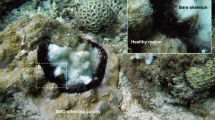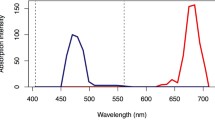Abstract
An in situ field study of the motility patterns exhibited by Phormidium corallyticum and Beggiatoa spp. in black-band disease of corals was conducted over a 5-day period. Measurements were made at a spatial resolution of 50 μm to document the horizontal migration of black-band across living coral tissue, while vertical migrations within the band were documented by observation and macrophotography of the black-band surface. It was determined that horizontal migration occurred both day and night, with the fastest movements by the front of the band during the day and the back of the band at night. Beggiatoa would rise to the band surface at night, and would often remain above the cyanobacterial population during extended periods of illumination the following day. The migration patterns are discussed in terms of motility cues and microbial physiology.
Similar content being viewed by others
References
Antonius A (1973) New observations on coral destruction in reefs. 10th Meeting Assoc Isl Mar Lab Carib 10:3(abstract)
Antonius A (1985) Coral diseases in the Indo-Pacific: a first record. PSZNI Mar Ecol 6:197–218
Antonius A (1988) Distribution and dynamics of coral diseases in the eastern Red Sea. Proc 6th Intl Coral Reef Symp 3:145–150
Carlton RG, Richardson LL (1995) Oxygen and sulfide dynamics in a horizontally migrating cyanobacterial mat: black band disease of corals. FEMS Microbiol Ecol 18:155–162
Castenholz RW (1968) The behavior of Oscillatoria terebriformis in hot springs. J Phycol 4:132–139
Castenholz RW (1982) Motility and taxes. In: Carr NG, Whitton BA (eds) The biology of cyanobacteria. University of California Press, Berkeley, pp 413–439
Castenholz RW, Jørgensen BB, D'Amelio E, Bauld J (1991) Photosynthetic and behavioral versatility of the cyanobacterium Oscillatoria boryana in a sulfide-rich microbial mat. FEMS Microbiol Ecol 86:43–58
Cohen Y, Rosenberg E (1989) Microbial mats: physiological' ecology of benthic microbial communities. Am Soc Microbiol, Washington, DC
Cohen Y, Jørgensen BB, Revsbech NP, Poplawski R (1986) Adaptation to hydrogen sulfide of oxygenic and anoxygenic photosynthesis among cyanobacteria. Appl Env Microbiol 51:398–407
Doemel WN, Brock TD (1974) Bacterial stromatolites: origin of laminations. Science 184: 1083–1085
Ducklow HW, Mitchell R (1979) Observations on naturally and artificially diseased tropical corals: a scanning electron microscope study. Microb Ecol 5:215–223
Edmunds PJ (1991) Extent and effect of black band disease on a caribbean reef. Coral Reefs 10: 161–165
Fechner R (1915) Die chemotaxis der Oscillatorien und ihre Bewegungserscheinungen uberhaupt. Z Bot 7:289–362
Garcia-Pichel F, Castenholz RW (1990) Comparative anoxygenic photosynthetic capacity in 7 strains of a thermophilic cyanobacterium. Arch Microbiol 153:344–351
Garcia-Pichel F, Mechling M, Castenholz RW (1994) Diel migrations of microorganisms within a benthic, hypersaline mat community. Appl Environ Microbiol 60:1500–1511
Garrett P, Ducklow P (1975) Coral disease in Bermuda. Nature 253:349–350
Hudson JH (1981) Growth rates in Montastraea annularis: a record of environmental change in the Key Largo National Marine Sanctuary, Florida. Bull Mar Sci 31:444–459
Jørgensen BB (1982) Ecology of the bacteria of the sulphur cycle with special reference to anoxicoxic interface environments. Phil Trans R Soc Lond 298:543–561
Jørgensen BB, Revsbech NP (1983) Colorless sulfur bacteria, Beggiatoa spp. and Thiovulum spp., in O2 and H2S microgradients. Appl Environ Microbiol 45:1261–1270
Jørgensen BB, Cohen Y, Revsbech NP (1986) Transition from anoxygenic to oxgyenic photosynthesis in a Microcoleus chthonoplastes cyanobacterial mat. Appl Environ Microbiol 51:408–417
Kuta KG, Richardson LL (1996) Abundance and distribution of black band disease on coral reefs of the northern Florida Keys. Coral Reefs (in press)
Malin G, Walsby AE (1985) Chemotaxis of a cyanobacterium on concentration gradients of carbon dioxide, bicarbonate, and oxygen. J Gen Microbiol 131:2643–2652
Møller MM, Nielsen LP, Jørgensen BB, (1985) Oxygen responses and mat formation by Beggiatoa spp. Appl Env Microbiol 50:373–382
Nelson DC (1992) Beggiatoa. In: Ballows A et al. (eds) The prokaryotes, 2nd edn. Springer-Verlag, New York, p. 3171–3180
Nelson DC, Castenholz RW (1982) Light responses of Beggiatoa. Arch Microbiol 131:146–155
Nelson DC, Revsbech NP, Jørgensen BB, (1986) Microoxic-anoxic niche of Beggiatoa spp.: microelectrode survey of marine and freshwater strains. Appl Environ Microbiol 52:161–168
Pentecost A (1984) Effects of sedimentation and light intensity on mat-forming Oscillatoriaceae with particular reference to Microcoleus lyngbyaceus Gomont. J Gen Microbiol 130:983–990
Peters EC (1993) Diseases of other invertebrate phyla: Porifera, Cnideria, Ctenophora, Annelida, Echinodermata. In: Couch JA, Fournie JW (eds) Advances in fisheries science: pathobiology of marine and estuarine organisms. CRC Press, Boca Raton, Florida, pp 393–441.
Porter JW, Meier OW (1992) Quantification of loss and change in Floridian reef coral populations. Amer Zool 23:625–640
Ramos-Flores T (1983) Lower marine fungus associated with black line disease in star corals (Montastraea annularis). Biol Bull 165:429–435
Richardson LL, Castenholz RW (1987) Diel vertical movements of the cyanobacterium Oscillatoria terebriformis in a sulfide-rich hot spring microbial mat. Appl Environ Microbiol 53:2142–2150
Richardson LL, Castenholz RW (1987) Enhanced survival of the cyanobacterium Oscillatoria terebriformis in darkness under anaerobic conditions. Appl Environ Microbiol 53:2151–2158
Richardson LL, Castenholz RW (1989) Chemokinetic motility responses of the cyanobacterium Oscillatoria terebriformis. Appl Environ Microbiol 55:261–263
Rützler K, Santavy DL (1983) The black band disease of Atlantic reef corals. I. Description of the cyanophyte pathogen. PSZNI Mar Ecol 4:301–319
Rützler K, Santavy DL, Antonius A (1983) The black band disease of Atlantic reef corals. III. Distribution, ecology, and development. PSZNI Mar Ecol 4:329–358
Taylor DL (1983) The black band disease of Atlantic reef corals. II. Isolation, cultivation, and growth of Phormidium corallyticum. PSZNI Mar Ecol 4:321–328
Whale GF, Walsby AE (1984) Motility of the cyanobacterium Microcoleus chthonoplastes in mud. Br Phycol J 19:117–123
Willey JM, Waterbury JB (1989) Chemotaxis toward nitrogenous compounds by swimming strains of marine Synechococcus spp. Appl Environ Microbiol 55:1888–1894
Williams EH, Bunkley-Williams L (1990) The worldwide coral reef bleaching cycle and related sources of coral mortality. Atoll Res Bull 335:1–71
Author information
Authors and Affiliations
Rights and permissions
About this article
Cite this article
Richardson, L.L. Horizontal and vertical migration patterns of Phorrnidium corallyticum and Beggiatoa spp. associated with black-band disease of corals. Microb Ecol 32, 323–335 (1996). https://doi.org/10.1007/BF00183066
Accepted:
Issue Date:
DOI: https://doi.org/10.1007/BF00183066




